PEARSON (PEARSON) • Information Technology 2016/2017 NQF
Latest uploads for Information Technology 2016/2017 NQF at PEARSON (PEARSON). Looking for Information Technology 2016/2017 NQF notes at PEARSON (PEARSON)? We have lots of notes, study guides and study notes available for Information Technology 2016/2017 NQF at PEARSON (PEARSON).
-
1008
-
4
-
127
Courses Information Technology 2016/2017 NQF at PEARSON (PEARSON)
Notes available for the following courses of Information Technology 2016/2017 NQF at PEARSON (PEARSON)
-
BTEC Unit 20 - Enterprise in IT 4
-
BTEC Unit 6 Website Development 2 Assignments 2
-
BTEC Unit 9 Project Management Assignment 1 2
-
BTEC Unit 9 Project Management Assignment 2 1
-
BTEC Unit 9 Project Management Assignment 3 1
-
Course specification 1
-
IT Unit 9 Learning Aim C Project Management (Dist 1
-
Unit 1
-
Unit 1 - Information Technology Systems 31761H 53
-
Unit 10 - Big Data and Business Analytics 9
-
Unit 11 - Computer Networks 1
-
Unit 11 - Cyber Security and Incident Management 45
-
Unit 12 - IT Technical Support and Management ITUNIT12 36
-
Unit 13 - Software Testing 17
-
Unit 13 - Website Development 1
-
Unit 13 - Website Development Level 2 BTEC 1
-
Unit 14 - IT Service Delivery 60
-
UNIT 14 – INSTALLING & MAINTAINING COMPUTER HARDWA 3
-
Unit 14 IT Service Delivery 1
-
Unit 15 - Customising and Integrating Applications 14
-
Unit 15 Cloud storage and Collaboration tools 1
-
Unit 16 - Cloud Storage and Collaboration Tools 18
-
UNIT 16 AUTOMATED COMPUTER SYSTEMS 5
-
Unit 17 - Digital 2D and 3D Graphics 30
-
Unit 17 Multimedia Product 3
-
Unit 18 - Digital Animation and Effects 19
-
Unit 19 - The Internet of Things MIT3019CF.2122 18
-
Unit 2 - Creating Systems to Manage Information 31761H 73
-
Unit 20 - Enterprise in IT 32
-
Unit 21 - Business Process Modelling Tools 5
-
Unit 3 - Assignment A - Investigating Social Media 1
-
Unit 3 - Using Social Media in Business ITUNIT3 123
-
Unit 3 Digital Portfolio 2
-
Unit 4 - Programming MIT3019CF.2122 91
-
Unit 4 - Programming, Assignment 1, Distinction 3
-
Unit 4 - Programming, Assignment 2, Distinction 2
-
Unit 4 - Programming, Assignment 3, Distinction 4
-
Unit 5 - Data Modelling ITUNIT5 72
-
Unit 6 - Digital Graphics 1
-
Unit 6 - Website Development Web 77
-
Unit 6 Digital Graphics 2
-
Unit 7 1
-
Unit 7 - Mobile Apps Development ITUNIT7 27
-
Unit 8 - Computer Games Development ITUNIT8 24
-
Unit 9 - IT Project Management Proman101 120
Popular books PEARSON (PEARSON) • Information Technology 2016/2017 NQF

Jenny Phillips, Alan Jarvis • ISBN 9781292140414

Pm Heathcote • ISBN 9781910523155

Pat M. Heathcote, Ann Weidmann • ISBN 9781910523148
Latest notes & summaries PEARSON (PEARSON) • Information Technology 2016/2017 NQF

Learning aims In this unit : A Understand the principles of website development
- Package deal
- Essay
- • 36 pages's •
-
PEARSON•Unit 6 - Website Development
-
BTEC L3 Unit 6 - Web design PART A, B & C Full Report Merit• ByTheITguy
Preview 4 out of 36 pages
Learning aims In this unit : A Understand the principles of website development
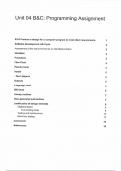
Learning aims In this unit you will: B Design a software solution to meet client requirements C Develop a software solution to meet client requirements.
- Essay
- • 20 pages's •
-
PEARSON•Unit 4 - Programming
Preview 3 out of 20 pages
Learning aims In this unit you will: B Design a software solution to meet client requirements C Develop a software solution to meet client requirements.

In this unit: A Examine the computational thinking skills and principles of computer programming. Unit in brief Learners study the underpinning concepts and implications of programming languages to design, develop and test computer programs. Unit introduction: Organisations and individuals increasingly depend on the functions and services offered by computing devices such as smartphones, tablets, laptops and personal desktop computers. You make use of computing programs when using an op...
- Package deal
- Essay
- • 18 pages's •
-
PEARSON•Unit 4 - Programming
-
BTEC L3 Unit 4 - Programming PART A, B & C Full Report Merit• ByTheITguy
Preview 3 out of 18 pages
In this unit: A Examine the computational thinking skills and principles of computer programming. Unit in brief Learners study the underpinning concepts and implications of programming languages to design, develop and test computer programs. Unit introduction: Organisations and individuals increasingly depend on the functions and services offered by computing devices such as smartphones, tablets, laptops and personal desktop computers. You make use of computing programs when using an op...
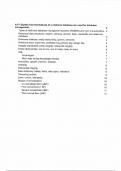
Learning aims In this unit : A Understand the purpose and structure of relational database management systems
- Package deal
- Essay
- • 12 pages's •
-
PEARSON•Unit 2 - Creating Systems to Manage Information
-
Unit 2: Creating Systems to Manage Information Full report Learning aim A, B and C• ByTheITguy
Preview 2 out of 12 pages
Learning aims In this unit : A Understand the purpose and structure of relational database management systems
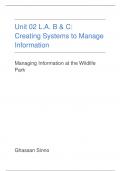
Report on the design, creation, testing and evaluation of a relational database system to manage information. Unit introduction: Relational databases are widely used to manage and process data to support, for example business processes and our social lives. From the smallest in-house systems to stock control systems for large multinational online retailers, databases are repositories of information that are a significant part of organisational operating requirements. You will examine the s...
- Package deal
- Essay
- • 53 pages's •
-
PEARSON•Unit 1 - Information Technology Systems
-
Unit 2: Creating Systems to Manage Information Full report Learning aim A, B and C• ByTheITguy
Preview 4 out of 53 pages
Report on the design, creation, testing and evaluation of a relational database system to manage information. Unit introduction: Relational databases are widely used to manage and process data to support, for example business processes and our social lives. From the smallest in-house systems to stock control systems for large multinational online retailers, databases are repositories of information that are a significant part of organisational operating requirements. You will examine the s...
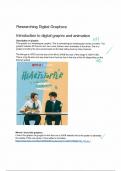
Unit in brief: student has designed and created digital graphics and animation in response to a client brief. Unit introduction: Digital graphics and animation are used in nearly all modern digital products to enhance the product and meet user needs. Whether it is characters in a computer game, the interface for a smartphone application (app), or diagrams designed to provide information on a website, digital graphics and animation make the product more engaging for the user and are vital to ...
- Essay
- • 27 pages's •
-
PEARSON•Unit 6 - Digital Graphics
Preview 3 out of 27 pages
Unit in brief: student has designed and created digital graphics and animation in response to a client brief. Unit introduction: Digital graphics and animation are used in nearly all modern digital products to enhance the product and meet user needs. Whether it is characters in a computer game, the interface for a smartphone application (app), or diagrams designed to provide information on a website, digital graphics and animation make the product more engaging for the user and are vital to ...

This is a completed assignment for BTEC IT. This is assignment 1 for Unit 6 website development (Learning aim A). This document was achieved to a distinction standard and includes a bibliography of sites used. It is broken down into sections so that it is easier to see where the merit and distinction standards have been achieved.
- Essay
- • 22 pages's •
-
PEARSON•Unit 6 - Website Development
Preview 3 out of 22 pages
This is a completed assignment for BTEC IT. This is assignment 1 for Unit 6 website development (Learning aim A). This document was achieved to a distinction standard and includes a bibliography of sites used. It is broken down into sections so that it is easier to see where the merit and distinction standards have been achieved.

This is a completed assignment for BTEC IT. This is assignment 1 for Unit 4 programming (Learning aim A). This document was achieved to a distinction standard and includes a bibliography of sites used. It is broken down into sections so that it is easier to see where the merit and distinction standards have been achieved.
- Essay
- • 24 pages's •
-
PEARSON•Unit 4 - Programming
Preview 3 out of 24 pages
This is a completed assignment for BTEC IT. This is assignment 1 for Unit 4 programming (Learning aim A). This document was achieved to a distinction standard and includes a bibliography of sites used. It is broken down into sections so that it is easier to see where the merit and distinction standards have been achieved.
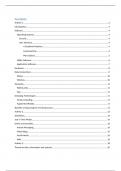
This unit has answered the set assignment and have completed a Pearson Set Assignment Brief covering the following: Learning aims: A. Explore how IT infrastructure meets the needs of organisations and their stakeholders B. Understand how organisations make use of data and information C. Develop policies for the use of IT within an organisation.
- Essay
- • 29 pages's •
-
PEARSON•Unit 1 - Information Technology Systems
Preview 3 out of 29 pages
This unit has answered the set assignment and have completed a Pearson Set Assignment Brief covering the following: Learning aims: A. Explore how IT infrastructure meets the needs of organisations and their stakeholders B. Understand how organisations make use of data and information C. Develop policies for the use of IT within an organisation.

Explain how principles of computer programming are applied in different languages to produce software applications. Explain how the principles of software design are used to produce high-quality software applications that meet the needs of users. Analyse how computational thinking skills can impact software design and the quality of the software applications produced. Evaluate how computational thinking skills can impact software design and the quality of the software applications produced.
- Essay
- • 16 pages's •
-
PEARSON•Unit 4 - Programming
Preview 3 out of 16 pages
Explain how principles of computer programming are applied in different languages to produce software applications. Explain how the principles of software design are used to produce high-quality software applications that meet the needs of users. Analyse how computational thinking skills can impact software design and the quality of the software applications produced. Evaluate how computational thinking skills can impact software design and the quality of the software applications produced.
